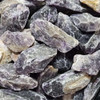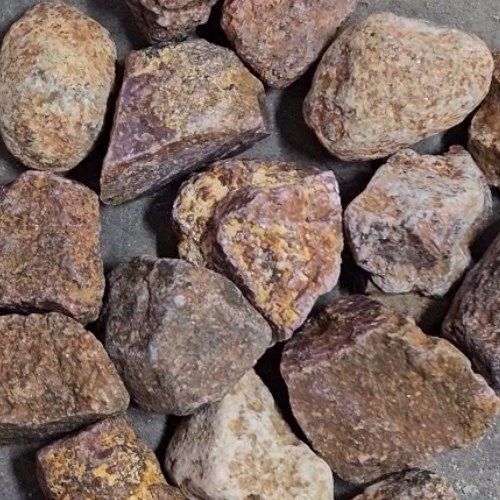Product Description
Amethyst Rough Stone - Select Size
Mineral Information:
Amethyst is a variety of quartz that is renowned for its purple coloration. It is one of the most popular and widely recognized gemstones in the world. Here are some key features and characteristics of amethyst:
Color: Amethyst typically ranges in color from pale lavender to deep purple. The intensity of the purple hue can vary, with some stones displaying lighter pastel shades and others exhibiting rich, saturated tones. Amethyst owes its color to trace amounts of iron and other impurities in the crystal structure.
Transparency and Clarity: Amethyst is generally transparent, allowing light to pass through it with varying degrees of clarity. However, it is not uncommon to find amethyst with inclusions or minor imperfections, such as tiny crystals, veils, or color zoning. The transparency and clarity of amethyst can impact its value and overall visual appeal.
Hardness: Amethyst has a hardness of 7 on the Mohs scale, which means it is relatively durable and able to withstand daily wear. However, like all gemstones, it can still be susceptible to scratches, chips, and fractures when subjected to rough handling or hard blows.
Origin: Amethyst is found in various locations worldwide. Major sources include Brazil, Uruguay, Zambia, Madagascar, and Russia, among others. Different localities can produce amethyst with slightly different shades of purple and unique characteristics.
Amethyst's captivating purple color and its association with spiritual and metaphysical properties have made it a beloved gemstone for centuries. Whether appreciated for its beauty, spiritual significance, or healing properties, amethyst continues to be highly valued and sought after by gemstone enthusiasts and jewelry lovers.
The name amethyst comes from the Koine Greek αμέθυστος amethystos from α- a-, "not" and μεθύσκω (Ancient Greek) methysko / μεθώ metho (Modern Greek), "intoxicate", a reference to the belief that the stone protected its owner from drunkenness. Ancient Greeks wore amethyst and carved drinking vessels from it in the belief that it would prevent intoxication. Until the 18th century, amethyst was included in the cardinal, or most valuable, gemstones (along with diamond, sapphire, ruby, and emerald), but since the discovery of extensive deposits in locations such as Brazil, it has lost most of its value. It is now considered a semiprecious stone. Amethyst is often used in jewelry and is the traditional birthstone for February.
Metaphysical Meaning:
Amethyst is highly regarded in metaphysical and spiritual practices. It is often associated with qualities such as spiritual protection, calming energy, clarity of mind, and emotional balance. Amethyst is believed to promote relaxation, intuition, and spiritual growth. It is frequently used in meditation, healing work, and energy cleansing practices.
Mineral Care:
Amethyst, despite its relatively high hardness compared to other gemstones, still requires careful handling to prevent fragility issues. Here are some factors to consider regarding the fragility of amethyst:
-
Hardness: Amethyst has a hardness of 7 on the Mohs scale, which makes it moderately durable. While it can withstand daily wear and tear, it is not completely scratch-resistant. Harder materials, such as other gemstones or objects with a higher Mohs hardness, can potentially scratch or abrade amethyst if they come into contact. It is best to store amethyst jewelry separately from other gemstones or harder materials to prevent scratching.
-
Cleavage: Amethyst has a conchoidal fracture, meaning it breaks with curved, shell-like surfaces. Although it lacks distinct cleavage planes, it can still exhibit some cleavage or weakness along certain directions. Care should be taken to avoid subjecting amethyst to forceful impacts or pressure in specific directions, as this can cause it to chip, fracture, or break.
-
Heat Sensitivity: Amethyst can be sensitive to rapid or extreme temperature changes. Thermal shock can occur when amethyst is exposed to sudden temperature fluctuations, such as moving from extreme heat to cold or vice versa. This can cause stress within the crystal structure, leading to cracks or fractures. It is advisable to avoid exposing amethyst to high heat sources or drastic temperature changes.
-
Sunlight Discoloration: Prolonged exposure to direct sunlight can fade or alter the color of amethyst over time. While this may not necessarily affect its structural integrity, it can diminish the visual appeal of the gemstone. To preserve the vibrant purple color of amethyst, it is recommended to store it away from direct sunlight when not in use.
-
Chemical Sensitivity: Amethyst is generally resistant to most household chemicals. However, it is still advisable to avoid exposing it to harsh chemicals, strong acids, or alkalis, as these substances can potentially corrode or damage the surface of the gemstone. It is best to remove amethyst jewelry before engaging in activities involving chemicals or cleaning agents.
To maintain the beauty and durability of amethyst, it is recommended to handle it with care, store it separately from other gemstones or harder materials, avoid subjecting it to rapid temperature changes or high heat, and protect it from prolonged exposure to direct sunlight. Regular inspections can help identify any potential issues or signs of damage, allowing for timely repairs or adjustments if necessary. By taking these precautions, amethyst jewelry or gemstones can be enjoyed for a long time.
Disclaimer:
No information here is intended to diagnose, treat or cure ailments or afflictions of any kind. One should always consult a medical professional if a serious issue presents itself.








